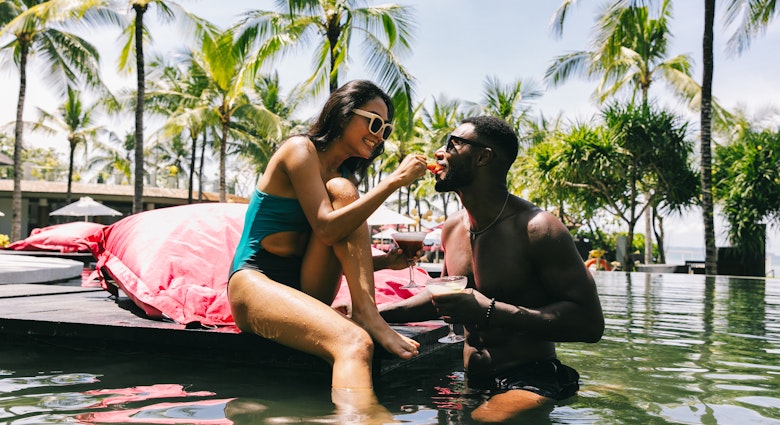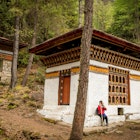If your idea of dining in Fiji conjures images of kitschy '80s seafood concoctions or fruit cocktails topped with paper umbrellas, then you’re going to be in for quite a treat when you arrive. Yes summery cocktails remain a fixture for swim-up bars and beachfront drinking, but the foodie scene in Fiji has continued to evolve in recent years.

Today restaurants from five star resorts to family-run local diners are all proudly celebrating indigenous flavours and fusion dishes from Fiji’s multicultural history. Indian migration has had the most pronounced influence on the eating habits of Fijians, but you’ll also note the flavours of Southeast Asia and China have been added to the mix.
Fiji is a nation of islands so the cost of importing processed food and non-seasonal produce is high. Instead, thankfully, Fijian chefs make the best use of local ingredients from tree ferns (ota) to fresh seafood and tropical fruits. Westerners may pine for cold climate staples like fresh berries with porridge or pancakes at their breakfast buffet (and high-end hotels can cater for these diners) but a quick way to immerse yourself in a new culture is at the dining table.
Dining out on dining experiences
Many resorts in Fiji boast internationally trained chefs (as well as excellent hospitality staff) serving guests gourmet dishes from seared yellowfin tuna and white scallops to king prawn curry laksa or wagyu beef steaks.
Salads and salsas are on the menu too with tangy ingredients like diced mango, fresh lime and chilli. Of course for kids, and more conservative diners, you're never too far from a barbecue or a pizza oven in most of Fiji's more popular spots.
No matter what you’re eating, water views always make for dining pleasures. Whether it’s an artfully composed seafood salad on a seaside terrace or simple pasta poolside, Fiji offers plenty of memorable dining experiences.
If it’s just a special occasion ask about private dining options. Fancy a candlelit cliff-side table with a personal butler at the ready while you sip cocktails and feast on fresh fish?
At Namale honeymooners have the choice of a romantic seaside cave or a secluded spot on the beach at sunset for their evening meal. For the rest of us, sampling from your breakfast tray in a beachfront bure (wood-and-straw hut) with the sound of waves lapping on the shore, or the rare coconut falling on the soft white sand nearby, makes room service pretty memorable.
No matter where you stay in Fiji breakfast usually consists of a spread of fruits, some pastries or bread, juice and darkly-roasted local coffee, grown in the country’s tropical mountains. Lunch can range from salads to fish to hearty curries, but we recommend you tread lightly in the middle of the day; dinners in Fiji can fast turn into feasts that feel more like a party with live music, dancing and multiple courses often on the cards.

Get into the kitchen
Now it’s time to take your newfound love of Indo-Fijian cuisine and raise the bar, by learning how to make some dishes yourself. Flavours of Fiji Cooking School (flavoursoffiji.com) in Denarau is handy for anyone staying at the nearby resorts, but also worth knowing about if you have a long layover before you head to a more remote island from Nadi airport. It’s a short drive from the airport (approx. 30 minutes) and a morning or afternoon spent cooking and sampling tasty Fijian dishes, while sharing stories and cooking experiences, is probably one of the best ways to get acquainted with Fiji.
This cooking school is run by two gorgeous Fijian women who have also lived and studied in Australia. Participants spend a half-day being taught how to choose the best ingredients, prepare, and cook various dishes including both Fijian favourites like ota vaka miti (a local tree fern infused with coconut milk, onion, tomato, chilli and lemon or lime), ika vakalolo (lightly fried fish simmered in coconut and served with Chinese cabbage), as well as traditional Indian dishes such as murghi aloo (chicken and potato curry).
The school prides itself on their home-cook style classes; this is not really the place for MasterChef-wannabes although they’ll be welcome as everyone is in Fiji. Classes see visitors preparing deceptively simple dishes, with careful instructions from the local teachers who also step in and offer a helping hand for those less gastronomically gifted (Is my cane sugar too hot, I can smell burning?).
In between the instruction, teachers and classmates share anecdotes about life: local mums who are up before dawn to make roti for the whole family cheekily chide the city dwellers who are more familiar with ready-meal curry brands than the fragrant spices of a sindhi kadhi (vegetable curry).

Produce markets and gourmet gardens
With plenty of sun and rain, Fiji is a food grower’s paradise. There are large produce markets in towns like Suva and Nadi as well as roadside stalls in more off-the-beaten-track areas, all stacked high with fresh produce at local prices. Forever living clean and green you’ll see fresh limes presented in washed out margarine containers or bunches of hand-picked fresh herbs wrapped in yesterday’s newspapers.
Markets are of course a great place to eat on a budget, but even if you’re on a fully-catered holiday it’s worth getting down to the markets of Fiji to touch and smell their unique produce first-hand. It’s also a good way to get out and meet some locals, and snap a few local life photographs but just ask before you shoot (though Fijians are fairly accommodating and forgiving people, quick to smile and not camera-shy). Make sure you buy – and try – some of their produce to return the favour.
Many hotels and resorts have their own local organic farms where they grow their produce. What you’re dining on even in the bigger resorts was probably hand-picked that afternoon. And you will taste the difference in the exceptional flavours of sun-kissed fresh produce especially if you spend most of your life living, working and eating in a big city. For farm-to-plate foodies, ask your hotel for a tour of their produce gardens to learn more about the unique cuisine of Fiji. Most are more than willing to share the experience and teach visitors more about their island’s favourite food and dishes.
Top places to eat
• Blue Bure (Nadi)
• Sofitel’s V (Denarua)
• Sheraton’s Ports o' Call (Denarua)
• Baka Blues Cafe (Pacific Harbour)
Lonely Planet's Destination Editor for Australia, New Zealand and the Pacific, Tasmin Waby, travelled to Fiji with support from Tourism Fiji, Fiji Airways and Air New Zealand. Lonely Planet contributors do not accept freebies in exchange for positive coverage.












